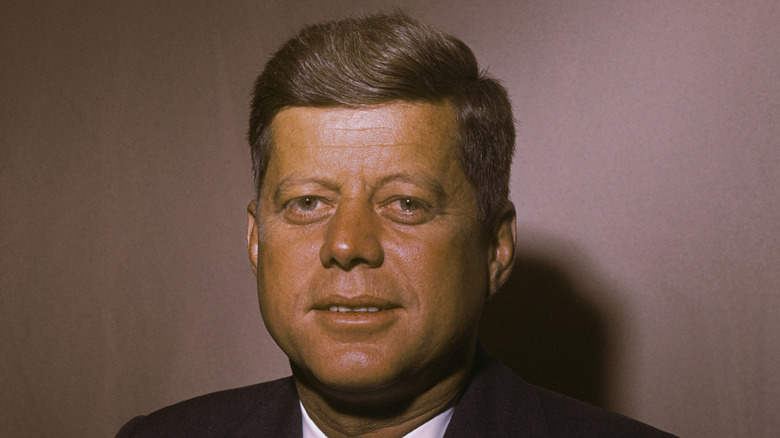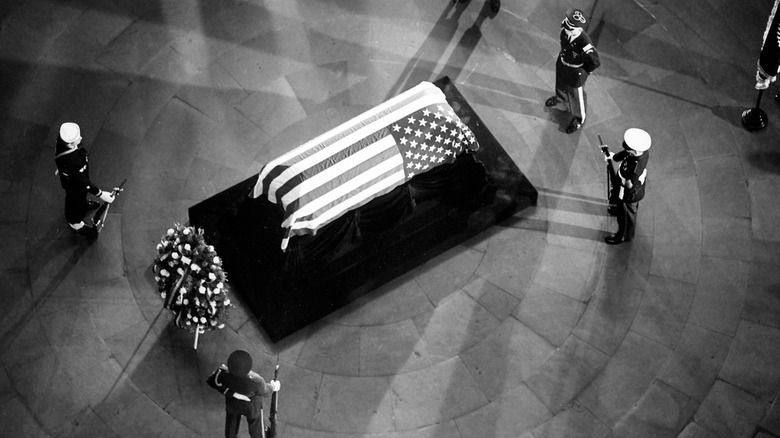The Real Reason JFK Had Two Caskets
These days, most everyone knows how President John F. Kennedy died, but far fewer may know that after he was killed, his body was kept in two caskets. Kennedy's body traveled to Washington, D.C. from Dallas, Texas, where he was assassinated, in a different casket than he was buried in at Arlington National Cemetery. The shocking and brutal manner in which Kennedy died is part of the reason why that happened.
After Kennedy assassin Lee Harvey Oswald's shots rang out in Dallas, Texas on November 22, 1963, the president's motorcade rushed him to Parkland Memorial Hospital, where he was pronounced dead. By the time Kennedy arrived back in Washington, the inside of the president's casket was in an awful state: His wounds had continued to leak blood, brain matter, and bodily fluids, ruining the interior. The casket would no longer do for the planned D.C. funeral, and he was transferred to a new one (via We Are The Mighty).
The story of the two Kennedy caskets underscores the degree of panic and uncertainty in the immediate aftermath of the president's death, as well as the gruesome nature of his wounds. For some sense of how badly the president was injured, doctors who performed his autopsy wrote (via The New York Times), "It is our opinion that the wound of the skull produced such extensive damage to the brain as to preclude the possibility of the deceased surviving this injury."
Robert Kennedy suggested the first casket be buried at sea
In Dallas in 1963, the first casket JFK's body was stored in was procured from O'Neal's Funeral Home, and before Kennedy's body was loaded into the casket to be transported back to Washington he was wrapped in sheets and the casket interior was covered in plastic. These measures proved insufficient, and another presentable coffin was found. In that second casket (seen above), Kennedy lay in state for two days and was buried at Arlington three days after he died (via LIFE).
In 1999, declassified documents revealed what happened to the first ruined casket. After Kennedy died, it was kept in a National Archives vault in D.C., the Los Angeles Times reports. The first casket's ultimate fate actually mirrors how Kennedy himself, a naval veteran, once thought he might want to be laid to rest: Three years after he was shot and killed, the casket was dropped into the ocean, per the Kennedy family's request (via CBS News).
Also according to declassified documents, John F. Kennedy's brother, Robert F. Kennedy was the one who suggested the first casket's final resting place. Robert told Archive officials, "What I would like to have done is take it to sea." But before that happened, 42 holes were drilled into it, it was weighed down with sandbags to make sure it sank, and two parachutes were attached to ensure it didn't break apart once it hit the water.
The casket sank off the Maryland-Delaware coast
Once JFK's first casket was prepared with holes, weights, and parachutes to help it sink and to keep it one piece upon impact, it was then taken from where it was stored at the Archives and loaded on a C-130 aircraft (similar to above). It reportedly now resides in an area off the Maryland-Delaware coast where the U.S. military sinks miscellaneous gear past its prime. According to Kermit L. Hall, a one-time member of the Assassination Records Review Board, formed in 1992 to review Kennedy assassination documents and disbanded in 1998, the first casket is now in "9,000 feet of water in the Atlantic Ocean" (via L.A. Times).
As the Los Angeles Times goes on to report, the two Kennedy caskets fueled conspiracy theories surrounding his assassination — could the disposal of the first casket be part of a larger cover up? Could the coffins have been switched, or could one of the coffins been empty, as some thought (via The New York Times)? According to those declassified federal documents, rather than become a pawn in some effort to obscure the real story of the JFK assassination, the first Kennedy casket was put under lock and key in the Archives and ultimately gotten rid of in "an effort to make sure the casket didn't turn into a historic relic for the marketplace," Hall said (via the Los Angeles Times).


